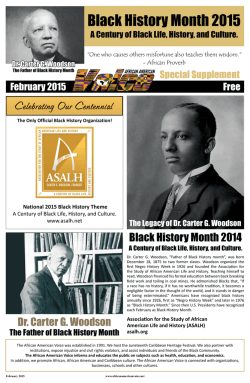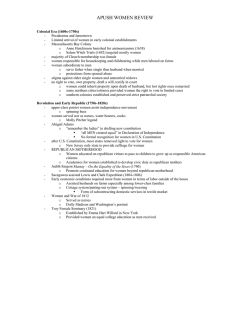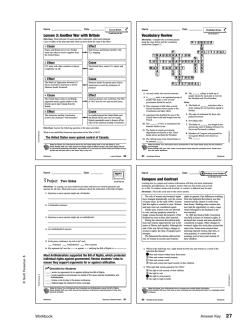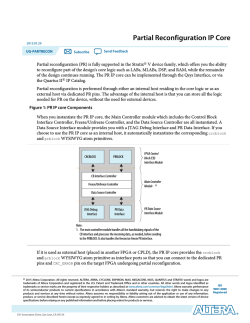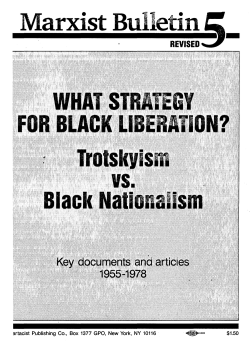
APUSH Black History Review
APUSH BLACK HISTORY REVIEW Colonial Era (1600s-1750s) I. Europeans Enslaving Africans a. Purchased captured slaves mostly from West Central Africa b. From Natives to Africans i. Natives difficult to enslave 1. succumbed to European diseases 2. unadjusted to intense agricultural labor 3. escaped due to knowledge of land ii. Reasons for African enslavement 1. less likely to escape in unfamiliar lands 2. easier to control due to language barriers between Europeans and tribal differences 3. dark skin made easy to identify and emphasized European superiority c. Middle Passage of Triangle Trade i. From Africa to the Americas ii. 20% of slaves died en route to colonies due to conditions, diseases, treatment, suicides II. First African Slaves in 13 Colonies a. First African slaves arrive in Jamestown, VA in 1619 b. Most labor in colonies depended on voluntary indentured servitude i. First African slaves established as indentured servants 1. released after certain amount of years ii. as colonies and plantations grew and more indentured servants released, labor became scarce 1. plantation systems in Virginia, North and South Carolina growing tobacco, rice, and indigo required intense labor 2. released black indentured servants became labor competition among whites 3. given European perception of blacks as inferior, Africans become lifetime slaves as dependent labor source III. Slaves in 13 Colonies a. Slave Demographics i. By 1700, 25,000 slaves in colonies; 10% of population ii. By 1790, 700,000 slaves in colonies iii. Northern colonies used slaves mostly for domestic servants or apprentices 1. Northern slaves accounted for 2% of population iv. Southern colonies used slaves mostly for plantation labor and domestic servants 1. Southern slaves accounted for 25% of population 2. by 1750, slaves accounted for more than 50% of population in South Carolina and Georgia b. Legal status of slavery i. Massachusetts first to legalize slavery in 1641 ii. Before American Revolution, all colonies legalized slavery 1. Quakers banned slavery, but Pennsylvania colonial government legalized slavery 2. laws protected inhumane treatment and killing of slaves iii. children born of slave mothers automatically slaves no matter legal status of father 1. Virginia passed first such law in 1662 iv. Manumission 1. freed slaves through acts or wills for hard work, guilty conscience c. Conditions i. Working Conditions 1. Field hands on plantations suffered the most due to intense field labor 2. domestic servants and skilled slaves fared better conditions ii. Family and Living Conditions 1. demeaning life under slavery 2. nuclear families separated by being sold off a. thus developed extended kinship ties to cope with conditions d. Uprisings and Slave Codes i. Stono Rebellion aka Cato Rebellion (1739) in South Carolina 1. 20 slaves launched an uprising killing whites, confiscating weapons, and liberating slaves 2. goal was to escape into Spanish Florida and amassed 100 participants 3. enraged whites recaptured and executed the rebels APUSH BLACK HISTORY REVIEW e. IV. Slave Codes i. As a result of Stono Rebellion and other uprisings, white colonists feared future uprisings ii. Colonial governments enacted slave codes to restrict and manage slave behavior Colonial Blacks a. By 1750, 200,000 blacks lived in the colonies; mostly slaves b. Free blacks i. Mostly lived and settled in urban centers ii. Rarely accepted into white-dominated colonial society iii. Suffered discrimination and possible kidnappings for enslavement APUSH BLACK HISTORY REVIEW Revolutionary Period (1750s-1780s) I. Opportunity during Revolution a. Tensions between colonists and Britain inspired slaves to resist or escape i. Some slaves posed as free men during war confusion ii. Some slaves escaped on British ships b. Choosing Sides i. Fighting for British - Loyalists 1. slaves believed loyalty to British would improve conditions or eliminate slavery and an American victory would entrench and deepen slavery 2. Lord Dunmore’s Proclamation (1775) a. Virginia governor provided emancipation in return for military support ii. Fighting for Americans – Patriots 1. Crispus Attucks first to die in Boston Massacre (1770) 2. George Washington initially rejected idea of blacks/slaves enlisting in military a. Changed his mind when British offered freedom 3. More than 5,000 blacks (mostly free) fought for Americans 4. Prince Hall, Boston abolitionist, argued for black participation war II. Philosophical Arguments a. British used irony of colonists demanding freedom from “enslavement” and no representation when some/most colonists own slaves APUSH BLACK HISTORY REVIEW Early Republic Period (1780s-1810s) I. Northern states start abolishing slavery a. Inspired by revolutionary rhetoric of freedom b. Pennsylvania gradually abolishes slavery in 1780 i. Frees future children of slaves; prior to 1780 enslaved for life ii. New Hampshire, Connecticut, Rhode Island, New York, New Jersey follow Pennsylvania model by 1804 c. Massachusetts abolishes slavery in 1783 II. Articles of Confederation a. Northwest Ordinance prohibits slavery (1787) III. Constitution a. Three-Fifths Compromise i. Deal between northern and southern states regarding representation where each slave counted as 3/5 a person ii. Northerners wanted abolishment of slavery and/or secure higher degree of representation over the South iii. South wanted slaves (much of the population) counted to prevent northern states from dominating the House of Representatives b. Article I, Section 9 i. Prohibits export and import of slaves (international slave trade) by 1808 c. Fugitive Slave Clause (Article IV) i. Extradition of fugitive slaves to claimants ii. Federal crime to assist or house fugitive slaves IV. Black Demographics a. In 1790, approximately 60,00 free blacks; in 1810, approximately 186,000 free blacks i. Revolutionary sentiments fueled manumission and wills in all regions b. In 1810, 95% of Virginia’s black population remained slaves c. 11% of total U.S. black population free V. Slavery as the “PECULIAR INSTITUTION” a. The South’s established plantation/agricultural economy stabilized by cheap slave labor i. Slavery argued as a NECESSARY EVIL b. improved conditions as slaves were an investment i. autonomy for travelling between plantations and urban centers ii. education and reading, especially through the Bible c. Eli Whitney’s cotton gin in 1793 i. Cotton production and fields increased substantially ii. Slave labor demand increased as King Cotton established 1. 70% increase in slaves 2. demand in slaves also increased with end of international slave trade in 1808 d. more slaves concentrated in Deep South i. cotton plantations more conducive in Deep South climate ii. Upper South diversified agriculture and traded/sold excess slaves to Deep South VI. Free Blacks a. Limited civic rights, education, and opportunities b. Benjamin Banneker (1731-1806) i. Astronomer, mathematician, surveyor, writer, farmer ii. Wrote letters to Thomas Jefferson vilifying him for slavery and racism in America c. Free African Society of Philadelphia (1787) i. Founded by Richard Allen and Absalom Jones ii. Religious-based association to provide economic and social guidance and assistance for blacks in Philadelphia VII. Black Codes/Slave Codes a. Gabriel’s Rebellion (1800) in Virginia i. Inspired by Haitian Revolution ii. Gabriel, educated blacksmith slave, began organizing large rebellion 1. free black population increased due to manumission 2. little restrictions for slave movement iii. conspiracy leaked and Gabriel and supporters all captured and executed b. Restrictions i. Education of slaves almost totally prohibited ii. Autonomy of slaves restricted, including movement/travelling iii. Free blacks forced/threatened to move out of state APUSH BLACK HISTORY REVIEW Antebellum Period and Sectionalism (1820-1860) I. Political Developments a. Political Parties i. Democratic Party 1. becomes party of slavery with Southern states, agricultural platform, and territorial expansion ii. Liberty Party (1840) 1. abolitionist party iii. Free Soil Party (1848) 1. against the expansion of slavery iv. Republican Party (1854) 1. absorbs Conscience Whigs, Free Soil, Liberty, and some Northern Democrats b. Congressional Balance i. By 1819, 11 free states and 11 slave states ii. House dominated by Northern representation, but Senate’s equal representation preserved South’s influence c. Missouri Compromise (1820) i. Missouri petitions for statehood and would become a slave state upsetting balance ii. Henry Clay’s compromise 1. 36’30 line prohibiting slavery above the line 2. Missouri enters as slave state, Maine as free state iii. Tallmadge Amendment 1. prohibit more slaves in Missouri and free slave children by 25 years old 2. voted down and dismissed for Clay’s idea d. Denmark Vessey Conspiracy (1822) i. Former slave who bought his freedom and organized massive slave revolt of slaves and free blacks in South Carolina ii. Intensified white fear and hysteria over slave revolts and rebellions e. Nat Turner Rebellion (1831) i. Led by slave, Nat Turner, resulting in over 50 whites murdered, but eventually suppressed and massacre of free blacks and slaves ii. Led to strict slave and black codes across the South f. Manifest Destiny i. Used by pro-slavery to expand slavery to preserve institution g. Texas and Mexican-American War (1836-1848) i. Texas Revolution 1. Mexico opened Texas for development and slaveowners moved into Texas a. Mexico abolished slavery upsetting American Texans 2. American Texans defeat Mexico and petition for statehood a. Would enter as a slave state b. Andrew Jackson opposed due to upsetting sectional balance c. John Tyler strongly endorses Texas annexation ii. Texas Annexation (1845) 1. James Polk endorses congressional resolution to annex Texas 2. leads to war with Mexico iii. Mexican-American War (1846-1848) 1. American victory led to control of Mexican Cession (California, Utah, Nevada, New Mexico, Arizona, Colorado) 2. Wilmot Proviso a. Admit Texas as slave state and Mexican Cession as free territory iv. Compromise of 1850 1. intense migration to California as a result of Gold Rush led to immediate petition for statehood upsetting sectional balance 2. Clay and Stephen Douglas’s plan a. California admitted as free state b. Mexican Cession land determines free/slave on popular sovereignty c. Strictly enforced fugitive slave law v. Fugitive Slave Law 1. any escaped slave may be recaptured and reclaimed 2. Special Commission determined alleged fugitive slaves free or slave a. Earned $10 for finding for claimant; $5 for finding for slave 3. right to trial by jury denied for blacks APUSH BLACK HISTORY REVIEW II. vi. Ostend Manifesto (1852) 1. failed secret deal to acquire Cuba as a slave state vii. Kansas-Nebraska Act (1854) 1. admit Kansas and Nebraska based on popular sovereignty 2. led to Bleeding Kansas and formation of Republican Party viii. Dred Scott v. Sanford (1857) 1. slaves as property thus Missouri Compromise ruled unconstitutional for violating property rights 2. blacks, slave/free, could never become citizens ix. Lecompton Constitution 1. proslavery document for Kansas endorsed by President Buchanan, but dismissed x. Harper’s Ferry (1859) 1. extreme abolitionist John Brown raids federal arsenal in Virginia to launch slave revolt, but failed 2. South enraged and view as Northern invasion conspiracy xi. Election of 1860 1. Democrats a. Stephen Douglas nominated for Democrats b. Southern states, upset with Douglas, nominate Breckenridge 2. Republicans a. Nominate Abraham Lincoln b. Southern states threaten to secede if Lincoln elected 3. Lincoln defeats Douglas and Breckenridge a. South Carolina secedes in December leading to Confederacy Blacks and Slaves in Antebellum Period a. Free Blacks i. Northern states provided limited economic opportunities with limited civil rights and education due to discrimination 1. skilled labor among blacks very limited 2. hired as cheap labor in some markets and industries, but suffered white resentment 3. increased immigration displaced blacks in the workforce ii. Southern free blacks lived in urban centers, especially in Upper South 1. suffered threat of kidnapping into enslavement and intense discrimination 2. rebellions severely restricted free black opportunities and movements b. Black Community i. Hampered by discrimination and restrictions, blacks developed their own economic and social communities ii. American Society of Free Persons of Colour (1830) 1. provide economic, social, and educational opportunities for blacks 2. support for abolitionism iii. Black church 1. Second Great Awakening led to conversion of blacks to Baptists and Methodists 2. became focal point and basis of black communities 3. formed separate congregations such as African Methodist Episcopal Church or First Baptist Church c. Abolitionism i. Characteristics 1. Inspired by Second Great Awakening for moral and social reforms 2. heavily concentrated in the North and severely restricted or prohibited in the South ii. American Colonization Society 1. developed to return blacks to Africa to solve “black problem” 2. led to founding of Liberia iii. American Antislavery Society 1. founded by William Lloyd Garrison for complete abolition of slavery 2. The Liberator published abolitionist articles iv. Frederick Douglass 1. self-taught escaped slave who founded The North Star to publish abolitionist articles APUSH BLACK HISTORY REVIEW 2. d. wrote autobiography: Narrative of the Life of Frederick Douglass, an American Slave v. Harriet Beecher Stowe 1. Uncle Tom’s Cabin (1852) inspired abolitionism among Northerners vi. Impending Crisis of the South (1857) by Hinton Helper 1. Southern author used empirical data to defend against slavery’s economic viability vii. Underground Railroad 1. escape routes through waterways and anti-slavery households from South to North/Canada 2. Harriet Tubman Slavery in the South i. Justification 1. Calhoun and Positive Good Speech a. Paternalism – owners as father figures b. Christian duty – saving from wilderness of Africa 2. Sociology for the South by George Fitzhugh a. Slavery essential and productive for slaves and even poor whites based on capitalist principles 3. Cannibals All! by George Fitzhugh a. Southern slaves live better and more productive lives than northern wage workers ii. Black and Slave Codes 1. Nat Turner Rebellion led to white hysteria and harsh restrictions for blacks across the South 2. anti-literacy laws prevented slaves and free blacks from learning to read and write 3. slaves could not congregate in large numbers 4. black churches required the presence of white ministers APUSH BLACK HISTORY REVIEW Civil War and Reconstruction (1860-1877) I. Lincoln, Union, and Slavery a. Border states (Kentucky, Maryland, Delaware, Missouri) remained “Union” and retained slavery b. Lincoln could not end slavery since it was constitutional and controversial i. Freed blacks could take jobs ii. Democrats used fear of freed slaves to gain seats in Congress c. Confiscation Acts i. Confiscation Act of 1861 labeled Union-freed slaves as “contraband of war” d. Emancipation Proclamation (1863) i. Freed slaves in Confederate states ii. Opportunity for blacks to fight for Union 1. Army of Freedom, i.e. 54th Massachusetts II. Confederacy a. Peculiar Institution suffers during war i. Poor whites fighting and Union invasions caused chaos on plantations ii. Tighter slave codes to control slave population b. Slave choices i. Most slaves stayed on plantations due to sense of familial loyalty and only escaped on approaching Union forces ii. Some slaves fought for masters, but Confederacy never fully endorsed conscripting slaves as contradictory to whole ideology of institution III. Civil War Amendments after Union Victory a. 13th Amendment – abolishes slavery b. 14th Amendment – citizenship in states and punishment for states who denied right to vote c. 15th Amendment – right to vote for blacks IV. Radical Reconstruction in the South a. Way of Life for Freed Slaves i. Prefer sense of autonomy with independent churches and own schools ii. Sharecropping and tenant farming 1. white landowners provided supplies for half of production 2. akin to slave plantation system iii. blacks use much of Mississippi Delta land to develop iv. only 5% of southern blacks claimed economic independence v. Move out West for new opportunities 1. Exodusters suffered same discrimination out West and only 20% became successful farmers b. Northern blacks to the South i. Used opportunities to develop and build schools and businesses ii. Sense of black identity and community Reconstruction South c. Black Codes (1866) i. Passed by former Confederate states limiting movement for blacks, prohibit interracial marriage, certification for certain jobs d. Freedmen’s Bureau (1865) i. Federal organization to assist free slaves and Southern whites gain employment, education, and relief e. Civil Rights Act of 1866 i. Guaranteed federal citizenship and enforcement of 13th Amendment f. Civil Rights Act of 1875 i. Equal accommodations and right to participate on juries g. Reconstruction Act of 1867 i. Former Confederate states placed into military districts ii. Federal troops enforced 15th Amendment h. Blacks voting in South i. 630 blacks elected to Southern state legislatures in 1870 ii. 16 blacks elected to House, one in Senate in 1870 iii. P.B.S. Pinchback elected governor of Louisiana i. Southern White Reaction i. Many whites refused to participate in elections due to Radical Reconstruction plans ii. Ku Klux Klan (1866) 1. paramilitary group as “invisible empire” to scare, abuse, destroy, kill opportunities for blacks and Republicans iii. White League APUSH BLACK HISTORY REVIEW j. 1. paramilitary group who openly attacked or killed blacks and Republicans Compromise of 1877 i. Rutherford B. Hayes (R) given presidency on condition of federal troops removed from the South ii. Ended most of Reconstruction programs in the South APUSH BLACK HISTORY REVIEW Gilded Age and Progressive Era (1877-1920) I. Redeemer Democrats and New South i. Southern politicians returned to power and began eliminating Reconstruction programs ii. Civil Rights Cases of 1883 1. Congress could not regulate racial discrimination of private citizens, even in business practices iii. Plessy v. Ferguson (1896) 1. separate but equal and desegregation iv. Jim Crow Laws in the South 1. segregated facilities in public places 2. disenfranchisement a. literacy tests b. poll taxes c. grandfather clauses d. white-only primaries 3. prohibited blacks from serving on juries, harsher penalties compared to whites v. discrimination and limited economic opportunities prevented blacks from learning trades and skills vi. lynching plagued blacks throughout the South II. Philosophical Developments a. Social Darwinism used to promote white sense of superiority over blacks and other races/minorities III. Black Response to Discrimination a. Progressives virtually ignored the plight of blacks since they either shared in racism or not a priority among other reforms b. Bishop Henry Turner and International Migration Society (1894) c. Booker T. Washington i. Former slave who promoted economic opportunity for blacks to gain civil rights and equality ii. Founded Tuskegee University in 1881 as industrial and agricultural school iii. Invited to white House dinner by President Theodore Roosevelt and friends with Andrew Carnegie d. W.E.B. DuBois i. Free Northern black promoted fight for black civil rights as way for opportunities ii. Founded Niagara Movement in 1905 and National Association for the Advancement of Colored People (NAACP) in 1908 e. First Great Migration (1910-1940) i. By 1900, 90% of blacks lived in the South; by 1910 began migrating to the North ii. Reasons 1. discrimination and segregation 2. harsh agricultural conditions 3. factory jobs during World War I iii. National Urban League (1911) 1. assisted blacks in adjusting in new urban life IV. World War I a. Job opportunities for blacks as whites drafted into military b. Segregated troops in military units c. During war and on return from Europe, whites enraged at loss of jobs and housing by blacks i. Led to race riots in Northern cities and lynchings in the South 1. East St. Louis, IL (1917) 2. Chicago (1919) killed 40 people APUSH BLACK HISTORY REVIEW Roaring Twenties to Depression to World War II (1920-1945) I. Roaring Twenties a. Great Migration continued as 20% of blacks lived in the North b. Marcus Garvey i. United Negro Improvement Association (1916) 1. advocated individual and racial pride among blacks 2. developed the concept of black nationalism leading to promotion of black pride, separatism, economic self-sufficiency c. Harlem Renaissance i. Harlem section of New York became largest black community ii. Concentration of talent and secured promotion of black expression 1. Langston Hughes – poet 2. Duke Ellington and Louis Armstrong – musicians a. Jazz music and jazz clubs i. Labeled as black music or devil’s music by white rural America 3. focused on wide range of emotions but promoted black pride and heritage d. Ku Klux Klan i. Emerged in 1915 in the Midwest, North, and South in response to Great Migration and immigration II. Great Depression a. Blacks join Democrats in New Deal Coalition i. Lumped with Southern Democrats 1. limited FDR’s support for blacks as he wanted to preserve Southern Democrats in coalition ii. Favored FDR’s New Deal relief programs b. Reduced and limited opportunities due to discrimination and depression i. First to be fired from jobs ii. Southern governments excluded blacks from New Deal relief programs iii. Lynchings continued in the South iv. Scottsboro Boys trial in 1931 1. nine blacks accused of raping two white women 2. no real evidence but led to convictions and death penalty III. World War II a. Increased job opportunities with war economy led to Second Great Migration (1940-1970) b. Segregated troops and military units usually reserved for menial chores i. Tuskegee Airmen never lost an escorted bomber on any of their missions c. Double V Campaign i. Promoted defeat of Axis Powers and end of racial discrimination d. NAACP increased membership and Congress for Racial Equality (CORE) i. Organized sit-ins and boycotts e. violence and race riots due to white worker resentment and upon return from service f. Smith v. Allwright prohibited denial of voting in primaries APUSH BLACK HISTORY REVIEW Post-World War II and Civil Rights Movement (1945-Present) I. 1940s Developments a. Jackie Robinson breaks race barrier in baseball (1947) b. Truman’s Executive Order 9981 (1948) i. Ended discrimination and segregation in military and federal government II. Spark of the 1950s a. Brown v. Board of Education of Topeka, Kansas (1954) i. Overturns Plessy v. Ferguson ii. End segregation in schools with all deliberate speed iii. Southern states resist by closing schools or preventing blacks from attending formerly white-only schools 1. Little Rock Nine (1957) a. President Eisenhower nationalizes Arkansas National Guard to ensure black students attend school b. Montgomery Bus Boycott (1955) i. Rosa Parks refuses to give up seat in Montgomery, AL and arrested ii. Martin Luther King Jr. launches boycott of public buses and launches his leadership iii. Supreme Court rules Alabama segregation laws on public transportation unconstitutional c. Southern Christian Leadership Conference (1957) i. Organized by King as network of civil rights organizations and black churches ii. Promoted nonviolent protest and resistance as key to victory d. Civil Rights Act of 1957 i. Establishes Civil Rights Commission to enforce right to vote for blacks e. Civil Rights Act of 1960 i. Enforcement of civil rights through the Justice Department and justices III. Nonviolent Resistance in 1960s a. Sit-ins (1960) i. Black and white students sit at segregated lunch counters ii. Passively resist racist reactions and gain sympathy iii. Student Nonviolent Coordinating Committee (SNCC) established to promote nonviolent resistance b. Freedom Riders (1961) i. Whites and blacks tour the South on buses to promote desegregation and integration ii. Suffer firebombs and white paramilitary group-led violence iii. Earns sympathy from national politicians c. Birmingham Campaign (1963) i. King arrested for protesting in Birmingham ii. President Kennedy calls for release bringing Kennedy’s support for movement d. March on Washington (1963) i. Political rally for equal opportunities for jobs and rights ii. “I Have a Dream” Speech by King e. Civil Rights Act of 1964 i. Prohibits discrimination in public accommodations and employment f. Selma March (1965) i. Marches from Selma to Montgomery to call attention to voting rights in the South ii. Met with constant violence and resistance by Southern whites g. Voting Rights Act of 1965 i. Inspired by March on Washington and Selma March ii. Eliminated Jim Crow laws disenfranchising blacks in the South IV. Black Power in the 1960s a. Nation of Islam i. Elijah Muhammad and Malcolm X promoted idea of black nationalism and separatism ii. Denounced slow pace of violent resistance and endorsed aggressive tactics iii. Believed in violent reactions b. SNCC and Stokely Carmichael i. Promoted black power leading to black pride and nationalism ii. Blacks should not be “begging” white politicians for rights, equality, and opportunities c. Black Panthers i. Founded by Huey Newton and Bobby Seale in 1966 ii. Provocative rhetoric 1. “Kill whitey” and “Burn, baby, burn!” iii. military posture and image APUSH BLACK HISTORY REVIEW V. 1. designed to protect blacks from abuse and brutality 2. exemplify show of force 3. engaged in violence, especially with police d. national reaction i. some whites considered black power as a threat to society ii. reactions and rhetoric often led to race riots in cities in late 1960s and early 1970s Post-Civil Rights Movement a. Affirmative action programs established to provide equal opportunities for blacks and other minorities i. Regents of University of California v. Bakke eliminated racial quotas but upheld affirmative action programs b. blacks and poverty i. government cuts in relief programs and limited social policies have led to impoverished families ii. poverty rates have affected nuclear families c. political opportunities i. Thurgood Marshall appointed to Supreme Court in 1967 1. Clarence Thomas appointed in 1991 ii. Jesse Jackson ran for president in 1984 and 1988
© Copyright 2024
